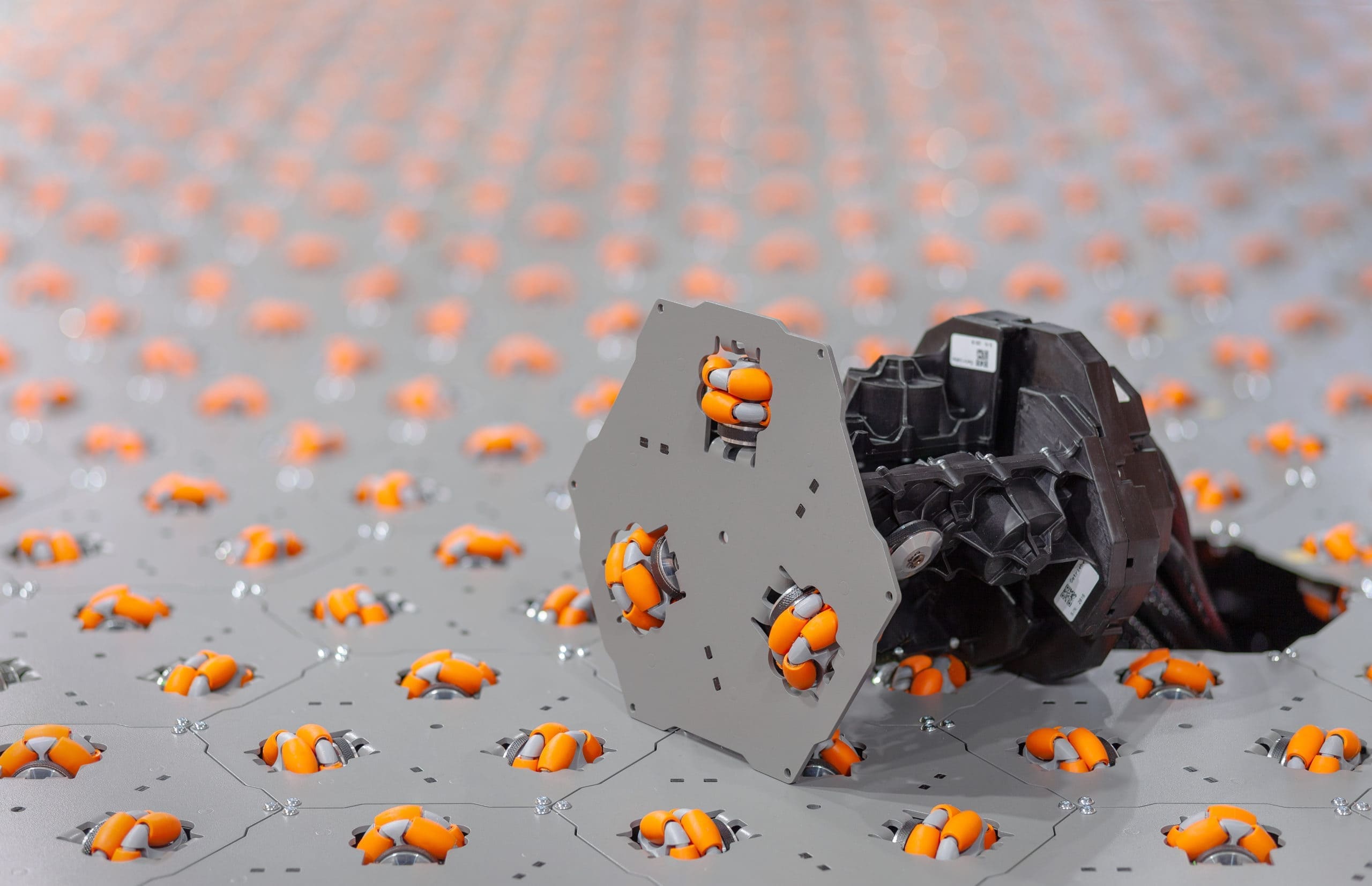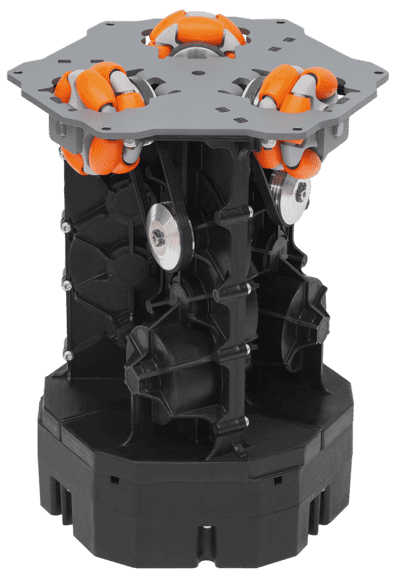Revolutionizing Material Flow:
The Impact of Robotics in Intralogistics
The development of robotics has made impressive progress in recent decades and is playing an increasingly important role in the transformation of industry and logistics. In intralogistics, smart assistants are transforming the organization of material flows.
Robotics and intralogistics
The robotics revolution in intralogistics
In recent years, innovative technologies such as the celluveyor have become key players in the field of material flow management. These advanced systems integrate seamlessly into intralogistics processes and offer numerous benefits that significantly improve the efficiency and flexibility of warehouse and production environments. This article sheds light on the development of these helpers and presents five convincing reasons why modern technologies in intralogistics are revolutionizing material flow in the long term.
Growing market
E-commerce: robotics as the key to optimizing intralogistics
The need to use robotics in intralogistics is directly linked to the challenges posed by the rapid increase in e-commerce. In recent years, we have all experienced first-hand people’s hunger for more and more goods from the Internet coupled with the race of online stores for the shortest delivery times. With the increasing number of orders in logistics centers, conventional processes, especially manual sorting, are reaching their limits. Distribution and logistics centers are bursting at the seams. This strain leads to increased downtime and delays, which are detrimental to both companies and customers.
Worth knowing!
159 billion parcels were sent
worldwide in 2021

Attempts to solve this problem simply by increasing staffing levels are being hampered by another challenge – the ongoing staff shortage in the intralogistics industry. The increasing demand for skilled labor, combined with a limited supply, makes it difficult to recruit sufficient staff for manual tasks. This not only leads to inefficient handling of increased order volumes, but also exacerbates the problems of downtime and delays. Performance losses are the order of the day.

In this context, the integration of robotics becomes an obvious and necessary solution. The use of automated solutions, such as those offered by cellumation in the field of intralogistics, not only enables an increase in efficiency, but also relieves staff of repetitive and physically demanding tasks. By using robots, logistics centers can cope with increasing demand, counteract breakdowns and minimize delays.
Automation solutions offer the advantage of continuous availability and precision, especially in the sorting process.
The technology from cellumation and other providers makes it possible to optimize the material flow in intralogistics, minimize bottlenecks and cushion performance peaks, which ultimately contributes to improved overall efficiency in intralogistics. Through the intelligent use of robotics, companies can meet the challenges of e-commerce and at the same time reduce the workload on intralogistics personnel.
The evolution of robotics in intralogistics
The advances in robotics for intralogistics reflect a fascinating evolution that has led from rigid, pre-programmed machines to intelligent, adaptive helpers. This development has been characterized by various development stages and milestones that have significantly influenced the adaptability and efficiency of the technologies.
- Rigid pre-programming: In the early days of robotics, machines were rigidly pre-programmed to perform specific tasks. This phase was characterized by limited flexibility and the need to manually reprogram machines for each new task.
- Progress through sensor technology: The use of advanced sensor technology was a decisive step in the evolution. By integrating sensors, robots were able to perceive their environment for the first time and adapt simple tasks without having to be programmed in detail in advance.
- Introduction of artificial intelligence (AI): The introduction of artificial intelligence opened up completely new possibilities. Robots in intralogistics became capable of learning and were able to adapt their actions dynamically. AI enabled continuous improvement and adaptation to changing requirements in the material flow.
- Dynamic adaptability: As development progresses, modern technologies can now adapt their actions in real time. This dynamic adaptability is crucial in order to operate efficiently in the complex environment of intralogistics.
The combination of these development stages and milestones has enabled automated allies to make the material flow in intralogistics more efficient. From rigid machines to adaptive robots – the evolution of robotics has led intralogistics into an era of efficiency and adaptability. These milestones have made the development of the celluveyor possible in the first place: the advantages of fully digitally conceived machines are played out holistically in this system and lead to flexibility and efficiency that seemed unattainable with conventional mechanical engineering in its current form until a few years ago.

Five reasons how robotics optimizes the material flow
Precision and efficiency:
Smart Assistants perform repetitive tasks with high precision, without performance fluctuations and at high speed, which leads to a significant increase in efficiency in the material flow.
Flexibility and adaptability:
Modern technologies can quickly adapt to different tasks and new performance requirements thanks to software updates.
Reduced workload and safety:
Automated Facilitators taking over physically demanding tasks relieves the burden on human workers and helps to improve occupational safety. In this way, we can direct human resources to more demanding and fulfilling tasks, while technology takes over the hard physical work that is still done today.
Round-the-clock operation:
The zero-touch trend reinforces round-the-clock operation in intralogistics, with intelligent helpers working continuously and without interruption 24/7. The use of automated solutions as part of this trend not only maximizes uptime, but also further increases efficiency in the material flow. This seamless, continuous operation helps to minimize throughput times, optimize the workload and at the same time raise overall efficiency in intralogistics to a new level.
Integration of artificial intelligence (AI):
Tech-driven Enablers in intralogistics use advanced AI algorithms to not only perform tasks accurately, but also to continuously learn and adapt to changing requirements. The integration of AI enables continuous improvement of processes to ensure optimum performance in the material flow.
E-commerce as a driving force
The celluveyor as a robotic solution
Flexibility
The special feature of cellumation lies in the flexibility, modularity and scalability of the cell-based, software-controlled technology. While other technologies aim to move goods from one point to another, cellumation goes one step further: with this technology, it is not the robot that moves, but the robot cell that acts as a surface for the direct movement of goods at the nodes in the flow of goods.
Hexagonal robot cells
The celluveyor products consist of any number of hexagonal robot cells, each with three omnidirectional wheels (omniwheels). Above the surface, a 3D camera recognizes the individual objects and acts as the “eye” of the system, transmitting information on size and height to the software. This controls the omniwheels independently of each other at a 360° angle, enabling controlled movements in the smallest of spaces. On outbound, the object always leaves the celluveyor in perfect orientation. Whether short side leading or long side leading, whether centered or aligned at the edge: This process step is included in the celluveyor so that no subsequent processes are necessary.
The software
The magic of the celluveyor products lies in the software: the vision system developed by cellumation recognizes the transported objects and provides real-time feedback on the respective position, calculates the optimal route to the exit and corrects deviations from the expected position through software-controlled individual tracking. The movements of the objects on the celluveyor are comparable to autonomously driving cars on the highway. Millions of possible movements are calculated in real time and the best option is selected. This enables collision-free movement, comparable to what experienced observers often see in human traffic at busy intersections. Digital twins are also used for increasingly efficient path calculation on the celluveyor interface, allowing performance upgrades through a software update after commissioning.
Innovation
The innovation lies in the flexibility of the application options. With an open structure, the functions can be combined and changed as required, enabling dynamic adaptation to changing conditions. The vision system with 3D cameras above the cells tracks the movements on the conveyor surface and transmits the information to the software control system. In a dynamic industry that is constantly facing new challenges, cellumation offers creative solutions to automate manual processes and improve conventional systems.
“Our goal is to leverage cutting-edge technology for swift, damage-free deliveries to our customers.“
In conclusion
It is clear that robotics in intralogistics has brought about a groundbreaking change in the way material flows are designed. The evolution from rigid, pre-programmed machines to intelligent, adaptive helpers, as represented by cellumation, illustrates the progress made in this industry. The use of robotics, especially in the context of the zero-touch trend, meets the challenges of e-commerce and not only increases efficiency, but also enables round-the-clock operation.
The benefits of robotics in intralogistics go beyond increasing efficiency. In the face of acute staff shortages, automation by robots offers the opportunity to perform repetitive tasks with precision and at the same time deploy human labor in a more targeted and profitable way. The integration of artificial intelligence and the flexibility of these technologies enable not only the precise execution of repetitive tasks, but also continuous adaptation to changing requirements. With its cell-based technology and unique vision system, cellumation represents a particularly innovative solution.
Let’s talk!
Let’s talk about how we can achieve the highest performance in your material handling system with our powerful celluveyor technology.


Tel. +49 (0) 421 331135 0
Fax +49 (0) 421 33 11 35 99
Mail info@cellumation.com
Kleiner Ort 7
28357 Bremen
Germany
Legal notice & Jobs
